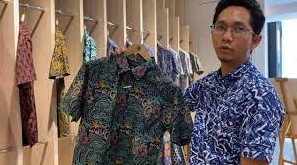
Providing skills in the form of a training workshop held in collaboration with the Faculty of Creative Industries, Department of Fashion Product Design, Ciputra University with resource persons consisting of lecturers who are quite experienced and competent in their fields. IKM under the guidance of the Blitar Regency Industry and Trade Service, consists of 10 members who face problems with a lack of development and skills in silk batik. regional training location with street address Plampangan hamlet, Jugo Village, Kesamben sub-district, Blitar Regency.
The stage begins by making a written batik motif with a prototype that is produced by applying the steps for making batik measuring 50X50 cm as a sample, starting with a small size first so that there are no mistakes during the process, where previously the participants had made batik motifs by attaching them with coktoto material. night but not yet colored. Continue making batik measuring 175 X115 cm with the characteristic motif of each participant. Work steps include:
Trace, that is, make a typical Blitar batik motif pattern on silk cloth in the desired size using a pencil. Once finished, it is coated with wax which has been heated using a canting whose heat must not exceed 60°C.
Cover the part of the pattern that will be given a different color so that the colors don’t mix up. Give color to the fabric with remasol dye and dissolved ASH soda, then dip it in waterglass (sodium silicate) solution.
After the coloring process is complete, the batik cloth is dried by air-drying for approximately 6 hours after the coloring process.
Nglorot, which is the process of removing the layer of wax wax by boiling the cloth, then rinsing with water. So that the colored motifs are clearly visible. The cloth that has been rinsed is then dried by drying it in direct sunlight.
In conclusion, this is a brief discussion regarding reviews of silk batik in the Blitar district IKM group. As a result of this practice, it is hoped that training can be held in the form of workshops in stages, hopefully participants will be able to understand the importance of this training as a strategy to achieve welfare goals for people who need training in the skills that have been developed. With training or applications to market products, entrepreneurs are able to create potential new entrepreneurs in Blitar Regency and can have a good influence in the surrounding areas by further exploring creative potential to improve the economy. With this training activity, it is also hoped that the potential will increase both in terms of the appearance of design motifs and in terms of sales strategies for the batik business to increase further.